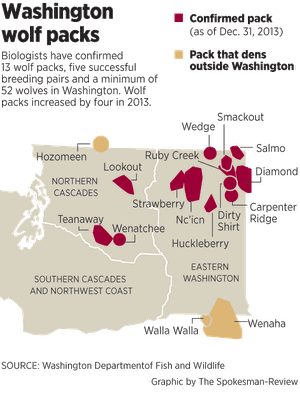Status report: Wolves continue expansion in Washington
ENDANGERED SPECIES -- Gray wolves established four new packs and expanded their territory in Washington over the past year, state wildlife managers told the state Fish and Wildlife Commission at a public meeting in Moses Lake today.
Coming Sunday, March 9, in The Spokesman-Review's Sunday Outdoors section: A package of stories about Washington wolf status and monitoring.
- Washington confirms 4 new wolf packs
- My feature story on the process of trapping a wolf for research monitoring.
- A photo story about the capture and monitoring of Wolf 47, which led to the confirmation of a new wolf pack in Washington.
Click "continue reading" to see the media release the Washington Department of Fish and Wildlife issued today, March 8, 2013, regarding the updated satus of wolves in Washington:
That assessment was based on an annual survey by the Washington Department of Fish and Wildlife (WDFW) that confirmed the presence of 13 wolf packs, five successful breeding pairs and at least 52 individual wolves in 2013.
Donny Martorello, WDFW carnivore specialist, said the latest findings point to continued growth in the state's wolf population under state and federal recovery plans.
"While we can't count every wolf in the state, the formation of four new packs is clear evidence of steady growth in Washington's wolf population," he said. "More packs mean more breeding females, which produce more pups."
All but eliminated from western states in the last century, wolves are now protected under Washington law throughout the state and under federal law in the western two-thirds of the state.
The commission, an appointed panel that sets policy for WDFW, approved the plan in 2011 that guides state management and recovery of wolves in Washington.
In developing its annual update, WDFW used a combination of aerial surveys, trackers and signals from 11 wolves fitted with active radio-collars, Martorello said.
Three of the new packs - Ruby Creek, Dirty Shirt and Carpenter Ridge - were formed by wolves that split off from the existing Smackout Pack in northeast Washington, he said.
A fourth new pack, the Wenatchee Pack, appears to be made up of two female wolves from the Teanaway Pack, whose territory stretches between Ellensburg and Wenatchee.
Under the state's Wolf Conservation and Management Plan, a wolf pack is defined in the state plan as two or more wolves traveling together.
Despite their growing numbers, wolves were involved in far fewer conflicts with humans and livestock in 2013 than in the previous year, Martorello said.
Stephanie Simek, WDFW's wolf conflict-resolution manager, said the department investigated 20 reported attacks on pets and livestock last year, but found that wolves were actually involved in only four of them. Confirmed wolf attacks left one calf dead and three dogs injured, she said.
By comparison, wolves killed at least seven calves and one sheep in 2012, leaving six additional calves and two sheep injured, Simek said. Most of those attacks were made by the Wedge Pack on a single rancher's cattle in northeast Washington, she said.
WDFW ultimately killed seven members of the Wedge Pack to stop the escalating series of attacks, although two wolves were still travelling as a pack in the same area in 2013, she said.
"That was an extraordinary event that we do not want to repeat," said Martorello, noting that no wolves were killed by WDFW last year.
The 2013 survey does, however, reflect the death of five wolves, due to causes ranging from a car accident on Blewett Pass to a legal hunt on the Spokane Indian Reservation.
Simek outlined several steps WDFW has taken in the past year to reduce conflicts with wolves:
Cooperative agreements: The department entered into cost-sharing agreements with 29 livestock producers, who have made a commitment to take proactive steps to avoid conflicts with wolves. Typical strategies include improving fencing and sanitation, employing range riders and using non-lethal hazing methods to repel wolves.
Increased staffing: WDFW created a new 13-member Wildlife Conflict Section to work with livestock producers, landowners and entire communities to avoid conflicts with wolves. Seven of those positions were new hires in 2013.
Wolf Advisory Group: A new nine-member advisory group was established to recommend strategies for encouraging more livestock owners to enter into cooperative agreements, providing compensation for wolf-related economic losses, and other issues. Members of the group represent hunters, livestock producers and conservation groups.
"These actions have greatly improved the department's ability to manage our growing wolf population and meet state recovery goals," Martorello said.
Under the state's wolf-management plan, wolves can be removed from the state's endangered species list once 15 successful breeding pairs are documented for three consecutive years among three designated wolf-recovery regions - or 18 successful breeding pairs in one year among three designated wolf-recovery regions.
A successful breeding pair is defined as an adult male and female with at least two pups that survive until the end of the calendar year.
In 2013, WDFW documented three successful breeding pairs in the Eastern Washington recovery region and two pairs in the North Cascades recovery region. No wolf packs or breeding pairs have been documented on the South Cascades/Northwest Coast recovery region.
Meanwhile, the federal listing of gray wolves under the Endangered Species Act is currently under review. In June 2013, the U.S. Fish and Wildlife Service announced a proposal to delist gray wolves nationwide. A decision is expected by the end of 2014.
An overview of the 2013 wolf survey is posted on WDFW's website at http:// wdfw.wa.gov/conservation/gray_wolf/. A full report will be available on that site by April 4, 2014.

